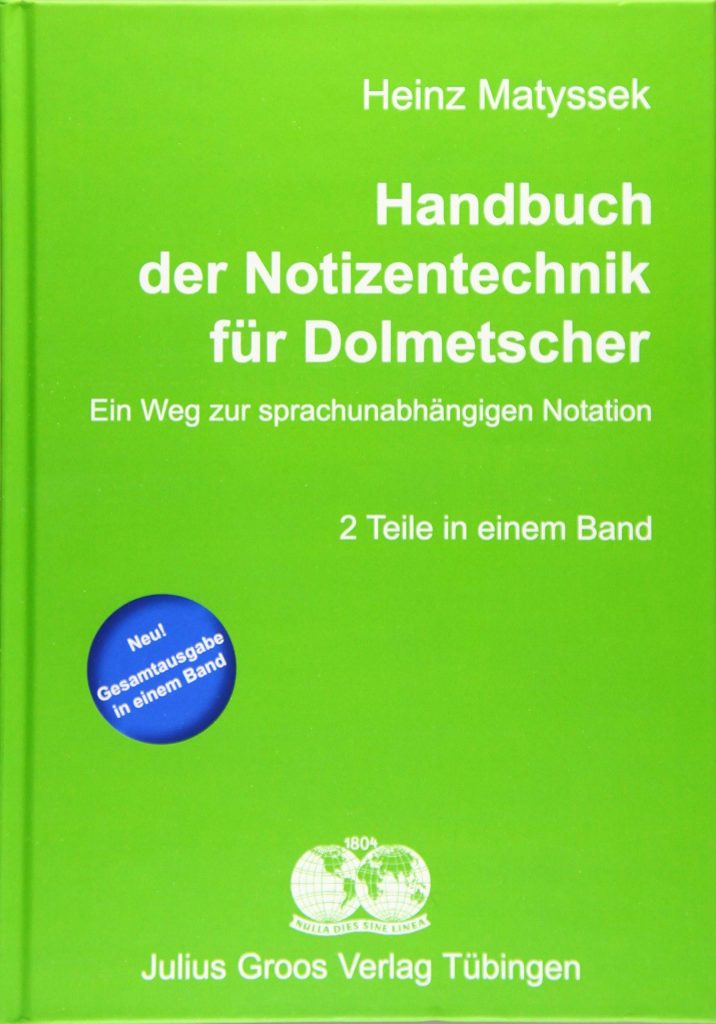The following is a translation/summary of pages 220-224 of Matyssek’s…
Handbuch der Notizentechnik fuer Dolmetscher, Heinz Matyssek
THe numbering is Matyssek’s. In the original you will also find references to examples of each point which are given elsewhere in Matyssek’s (500 page) work. You can find Matyssek’s Symbols basics here:
(Bear in mind that Matyssek worked and taught in the combination DE-EN and some of the points below are quite specific to that language combination).

Note-taking basics, Matyssek
1. Note the essence of meaning (tragenden Essenz), not the words and pass that on to your audience
2. Start taking notes as soon as the speech begins
3. Only note what is necessary to in order to interpret. Don’t note the obvious, that which is clear from context and that which can be remembered.
4. Names, dates and numbers are an essential part of notes.
5. Keywords are the pillars on which meaning is built and are therefore noted.
6. Verticality is an essential part of note-taking. Verticality makes it possible to organise ideas logically and give the correct weight to each part and to quickly and thoroughly get across the speakers line of argument.
Verticality is essential for lists. It also makes it possible to note a gap.
7. Margin : by varying the distance from the margin indicates main and subordinate elements are distinguished. “Hierarchisation” of elements is thus visible on the page. This basic skeleton of the speeches meaning aids memorisation of other elements.
8. Horizontal line from the margin between parts of the message (Sinnschritte) prevents ithese parts merging [unintentionally]. It also makes it possible to jump to other iparts of the message if asked to summarise a speech.
9. Omission – leaving gaps or using the link line, or derivation line (aka reference arrow) – means not noting something already used or defined and leaving a gap in its place or by running a line or an arrow from the first mention to that place. This means less work is involved in taking the notes, saves energy and makes the notes themselves streamlines the notes without compromising accuracy.
10. What language to take notes in – over and above the language non-specific symbols – is an issue that divides expert opinion. This decision should be left up to each individual interpreter. Long experience suggests note-taking in, or into, the mother tongue is the right way to go.
11. Noting words makes abbreviation essential. Note the beginning and the end of each word. There will be occassional exceptions to this rule.
12. Fixed rules for the position of noted elements on the page are found in the literature but are rejected here. Meaning-based, thus syntactical, hierarchisation is essential. Generally this is Subject Predicate, Object
13. Transmission elements in the chain of thought should be noted at the left of the pad so they stand out.
14. Tenses and moods are almost always essential to meaning and so should be noted.
15. Number [singular or plural] and if necessary gender are meaning-critical and should be noted.
16. Refuting or confirming, emphasis or down-playing are meaning-critical elements and must be carefully recorded in staggered notation.
17. Prepositions should only be noted where absolutely necessary.
18. A slash between to elements in the notes to denote the Genitive – often meaning-critical – seems essential.
19. Pronouns are only noted when they serve to clarify contextual meaning.
Demonstrative pronouns are noted when they are meaning-critical for part, or all, or the message.
Interrogative pronouns are to be noted as required.
Personal pronouns – where they define the Subject or change thereof – are to be noted in the margin at the left of the pad.
Possessive pronouns are generally unnecessary.
Relative pronouns can generally be deduced from context and don’t need to be noted.
20) Attributes are only noted when a) not clear from context or b) are meaning-critical
21) Comparatives and superlatives are meaning-critical and should be noted, if they are not already obvious from context.
22) Short-hand does not work as a means for note-taking and should be rejected. However selected borrowings from short-hand are possible.
22) The note-pad should be small and manageable. A6 spiral-bound pads are to be recommended.